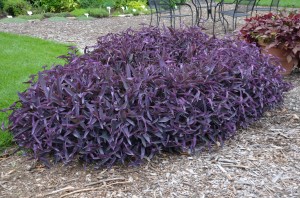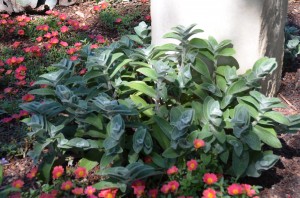Purple Heart tradescantia (Setcreasea pallida ‘Purple Heart’), formerly Tradescantia purpurea), is an annual trailing groundcover with purple stems and violet-purple foliage. This flowering vine is primarily grown for its vibrant foliage. Purple Heart is utilized in garden beds, large containers or hanging baskets. By summer’s end individual plants may grow 8-12 inches tall and spreading 16 inches wide.
Purple Heart grows best in full sun to light shade. Its foliage color is darkest in bright sunlight and purple hue diminshes under lower light levels. Colorful leaves may reach 7 inches in length, most often 3-5 inches.
Over the first 4-6 weeks pinch growing tips to encourage better branching and bushier plant habit. Note: pinched cuttings root easily. Small 3-petalled, pale pink flowers appear in late summer. Cut back flowering stems in late summer after blooming to improve plant density. Water frequently and fertilize to establish plant(s). Feed monthly with water soluble fertilize such as Miracle-Gro™, Nature’s Source™ or Schultz™. Plants become very drought tolerant in late summer.
Purple Heart is easily propagated from vegetative cuttings. Stick 3- to 5-inch long tip cuttings in a loose, airy soil mix of medium grade perlite, or gritty sand, or water. Cuttings root quickly, usually within 2-3 weeks. Pot them up to start other container(s) or add to existing garden bed in spring and summer.
Viruses, aphids, spider mites may be occasional problems. Discard virus infected plants immediately.
In mid-autumn frugal gardeners collect cuttings and grow Purple Heart indoors over winter. New cuttings can be started in spring and moved into back to the garden in mid- to late spring.
Others spiderworts to consider:
‘Cobweb’ spiderwort (T. sillamontana) is a wonderful plant collector’s oddity. Native to the mountains of northern Mexico (zones 7b – 10), it remains evergreen in zone 8b and further south. Gray-green leaves and thick stems are covered with white hairs (“cobwebs”). It sports deep pink three petal flowers.
S. pallida ‘Blue Sue’ is a passalong plant sold by Plant Delights Nursery in Raleigh, NC (zones 7b – 10). The 2-inch wide x 5 inch long bluish gray leaves clasp upright dark purple stems; forms an 18 inches tall x 5 feet wide patch over 10 years. Small diurnal lavender flowers appear in late June (NC). Tony Avent recommends it as a groundcover around open branched shrubs, including roses.



 Posted in
Posted in 
